In this blog post: A conversation with Will Richardson, Majora Carter, and kids making video games
I spent Saturday in my own time zone. It was wonderful, New York City, and I had a wonderful, if strenuous, evening with my youngest brother, who lives there. We started at the Hilton where the conference was, walked up to and across Central Park. Then down to his apartment in Chelsae, and then down into Greenwich Village for an meal of (hot) Indian Cuisine. Then I walked the fifty some blocks back up the the Hilton.
I thought that the conference was great, the parts of it that I was able to enjoy. I was interviewed by Channel 21, one of New York’s Public Broadcasting stations, and had to be made up before had. I looked real good. My hair did not move for at least two and a half hours. My presentation was supported by what seemed to be a full studio of sound and video technicians, not to mention a stage manager and assistant stage manager. That was fun.
One of the best parts of the conference, to me, was having breakfast with Will Richardson. He brought me down — talking about some of the sessions he’d seen the day before, and the incredible disconnect between the message delivered by the presenters and the realities of the in-the-trenches educators who were asking questions. Quite frankly, I think that it is probably more accurate to say, “the realities expressed by the presenters, and the fantasies imposed on in-the-trenches educators.” You can read more about Will’s take on the conference at his blog. At least I didn’t order sausage for breakfast. Read the sixth paragraph in his post, and know that I agree with him. Meat is incredibly expensive to the environment. I do eat meat, but only when I’m on the road where it is difficult to impossible to control my diet.
 The second “best” part of the conference was getting to see Majora Carter.
The second “best” part of the conference was getting to see Majora Carter.
Majora Carter is connecting poverty alleviation with environmentalism by demonstrating solutions for urban public health problems and global climate concerns. Carter lives and works in the South Bronx, and founded Sustainable South Bronx in 2001 to fight for environmental justice through innovative, economically sustainable projects that are informed by community needs.
You can read more of her bio here and here. It was an amazing talk from someone who has an amazing stage presence. She has spoken at TED as well, and here is a link to her talk there — which appears to be disabled at this moment. It isn’t everyday that you get to see a real hero!
The third best thing that I learned at the celebration was a real surprise. While dashing through the exhibitor’s area, I caught site of a booth from Homeland Security. Well the hairs stood up, a bit, on my back, and I ambled over to learn what they were doing here and to, perhaps, pick on them a bit. The man there was probably around my age, though much more fit/slim, and dressed quite casually. I asked about their presence at an education conference, and he started talking about video games. He first gave a rather rehersed sounding speech about how video games are being used to train emergency workers.
But he quickly fell into a more comfortable topic, that of teaching students to develop their own video games. He showed me Scratch, a video game building platform, developed at MIT. My new acquantance was a full time teacher and he works part time at MIT. He explained that they had been trying to align the instructional benefits of having kids program games to state standards, but weren’t getting any where with that. So they are now promoting it as an after school activity. I think that this says a lot about the abysmal place that U.S. education is in.
Why are our standards a reason NOT to teach something?
 Anyway, I came home yesterday and downloaded Scratch, and in only a few hours, taught myself the fundamentals of the language, which is object oriented. Your programming elements are graphical objects that you drag out of bins and then attach to your programs/scripts in logical positions. To the right is the program script that controls the ghost in the game I made below.
Anyway, I came home yesterday and downloaded Scratch, and in only a few hours, taught myself the fundamentals of the language, which is object oriented. Your programming elements are graphical objects that you drag out of bins and then attach to your programs/scripts in logical positions. To the right is the program script that controls the ghost in the game I made below.
I’m thinking of all kinds of math and logical process thinking that this sort of activity can promote. It really shouldn’t be so hard to make a case for student’s programming as a learning activity, but it is and it has been for a very long time.
Perhaps part of the problem is that it’s not about teaching. It’s about learning. When students are learning about angles and measures by directing a sprite (or a turtle) around on the screen, based on outside influences, they are learning these concepts and practices, not being taught them.
Well, I had fun playing with it. Here’s a game called Ghost Trap that I put together yesterday and uploaded to the Scratch site this morning.

Technorati Tags: warlick education technology videogames scratch mit thirteencelebration
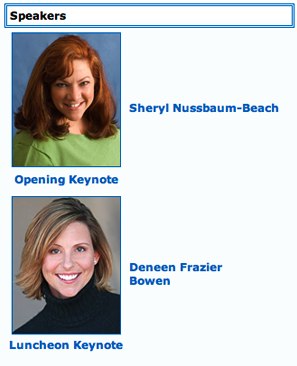 One unusual, but welcomed aspect of this conference is that both keynote speakers are women. I often hear from conference organizers that they are looking for more women to deliver their large group addresses. I am certainly looking forward to both of these, Sheryl Nussbaum-Beach kicking off the general conference on Thursday and Deneen Frazier Bowen for the closing banquet. Hmmm, do I need to add something to my name? David Aloysius Warlick?
One unusual, but welcomed aspect of this conference is that both keynote speakers are women. I often hear from conference organizers that they are looking for more women to deliver their large group addresses. I am certainly looking forward to both of these, Sheryl Nussbaum-Beach kicking off the general conference on Thursday and Deneen Frazier Bowen for the closing banquet. Hmmm, do I need to add something to my name? David Aloysius Warlick? 
 Perhaps the best single concept that describes where we should be focusing our efforts, as educators, is constructivist learning. Gary Stager e-mailed me an announcement about an event being attached to NECC this year in San Antonio, the second annual (June 29)
Perhaps the best single concept that describes where we should be focusing our efforts, as educators, is constructivist learning. Gary Stager e-mailed me an announcement about an event being attached to NECC this year in San Antonio, the second annual (June 29)  The second “best” part of the conference was getting to see Majora Carter.
The second “best” part of the conference was getting to see Majora Carter. Anyway, I came home yesterday and downloaded
Anyway, I came home yesterday and downloaded 
 I arrived at the Hilton in downtown (or is it uptown) NYC about midnight last night. It’s one of those cool little “Look at Me” things that occassionally acompany what I do, to land in an airport and be picked up by a limo (town car). Wouldn’t seem like much to most, but where I grew up — well that’s special. Of course, as I ride down that escalator at Newark Liberty Airport, there are about fifty drivers, dressed in black, probably from more than 50 nationalities, each holding a sign out with somebody’s last name. They each lift their signs, as the see me paying attention, as if they’re saying, “pick me, pick me!”
I arrived at the Hilton in downtown (or is it uptown) NYC about midnight last night. It’s one of those cool little “Look at Me” things that occassionally acompany what I do, to land in an airport and be picked up by a limo (town car). Wouldn’t seem like much to most, but where I grew up — well that’s special. Of course, as I ride down that escalator at Newark Liberty Airport, there are about fifty drivers, dressed in black, probably from more than 50 nationalities, each holding a sign out with somebody’s last name. They each lift their signs, as the see me paying attention, as if they’re saying, “pick me, pick me!” Yesterday’s Literacy Promise Conference in Salt Lake City was phenomenal. Most of the presentations were very traditional, in that they addressed standard classroom challenges of teaching reading, vocabulary, etc. — and they did it brilliantly. I should buy some of their books, because the classroom ideas were amazing, all paper-based, but amazing. I presented on contemporary literacy, once in the morning and again in the afternoon. The morning session was fairly full, but the afternoon audience seemed much more filtered — many obviously warned to stay away, because he wasn’t talking about OUR literacy, but a few told by the mornings attendees, you have to see these ideas. It was a great audience. This was possibly the best blogged session I’ve presented in a very long time, with giants like Darren Drapper and Kelly Dumont in the audience.
Yesterday’s Literacy Promise Conference in Salt Lake City was phenomenal. Most of the presentations were very traditional, in that they addressed standard classroom challenges of teaching reading, vocabulary, etc. — and they did it brilliantly. I should buy some of their books, because the classroom ideas were amazing, all paper-based, but amazing. I presented on contemporary literacy, once in the morning and again in the afternoon. The morning session was fairly full, but the afternoon audience seemed much more filtered — many obviously warned to stay away, because he wasn’t talking about OUR literacy, but a few told by the mornings attendees, you have to see these ideas. It was a great audience. This was possibly the best blogged session I’ve presented in a very long time, with giants like Darren Drapper and Kelly Dumont in the audience. It’s really been hard for me to distinguish the days of the past week. For instance, it seems that it was only a few hours ago that I presented at the NAACE conference in Torquay. Then we got on a train for about three hours, then a plane for about seven hours, then a hotel room for about three hours, then another plane for five hours, then I’m in a hotel in Salt Lake City, and it’s 5:00 PM. Where in the heck is the sun right now, anyway? My clock says it’s 5:30 AM, Mountain Time.
It’s really been hard for me to distinguish the days of the past week. For instance, it seems that it was only a few hours ago that I presented at the NAACE conference in Torquay. Then we got on a train for about three hours, then a plane for about seven hours, then a hotel room for about three hours, then another plane for five hours, then I’m in a hotel in Salt Lake City, and it’s 5:00 PM. Where in the heck is the sun right now, anyway? My clock says it’s 5:30 AM, Mountain Time.


 We landed around midnight last night at JFK and spend a few hours sleeping in a Fairfield inn. I left Brenda and Martin at American Airlines for a short flight home and I’m spending a fairly comfortable morning at the JetBlue gates with WiFi and 110 electricity. Tomorrow, I’ll be speaking at a literacy conference in Salt Lake City, and am anxious to learn how my geeky ideas will resonate with them.
We landed around midnight last night at JFK and spend a few hours sleeping in a Fairfield inn. I left Brenda and Martin at American Airlines for a short flight home and I’m spending a fairly comfortable morning at the JetBlue gates with WiFi and 110 electricity. Tomorrow, I’ll be speaking at a literacy conference in Salt Lake City, and am anxious to learn how my geeky ideas will resonate with them. Niel McLean, of Becta, is talking about what technology is doing for students. He makes a point about how traditionally we have seen boys work in bursts, while girls seem to move through their learning fairly steadily. However, when ICT is involved in the learning experience, boys tend to become more steady with their activity.
Niel McLean, of Becta, is talking about what technology is doing for students. He makes a point about how traditionally we have seen boys work in bursts, while girls seem to move through their learning fairly steadily. However, when ICT is involved in the learning experience, boys tend to become more steady with their activity.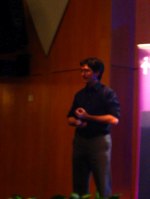
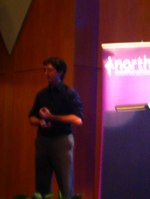
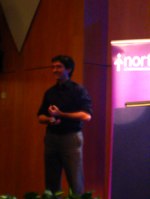
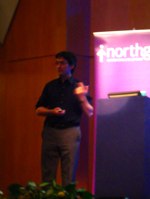
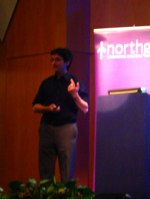
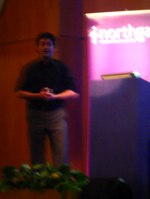
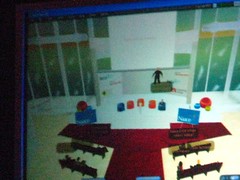
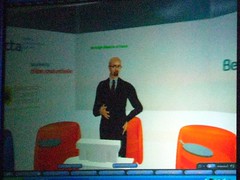

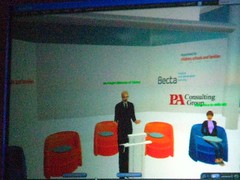
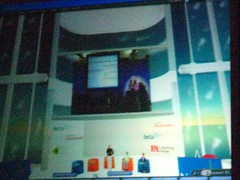
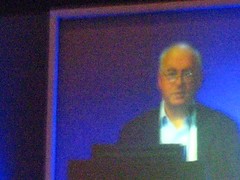 The current speaker is Professor John Naughton, and he is drawing extensively from Niel Postman. He’s making an interesting point about our shift from information scarce environments to information abundant environment. He says that our mistake has been to think of information as an economy. It’s why, with the rise of broadcast TV, it was predicted that TV would wipe out Radio. He says that it may be much more helpful to think of the information environment as an eco-system. It does a much better job of handling the complexities of the information landscape.
The current speaker is Professor John Naughton, and he is drawing extensively from Niel Postman. He’s making an interesting point about our shift from information scarce environments to information abundant environment. He says that our mistake has been to think of information as an economy. It’s why, with the rise of broadcast TV, it was predicted that TV would wipe out Radio. He says that it may be much more helpful to think of the information environment as an eco-system. It does a much better job of handling the complexities of the information landscape.